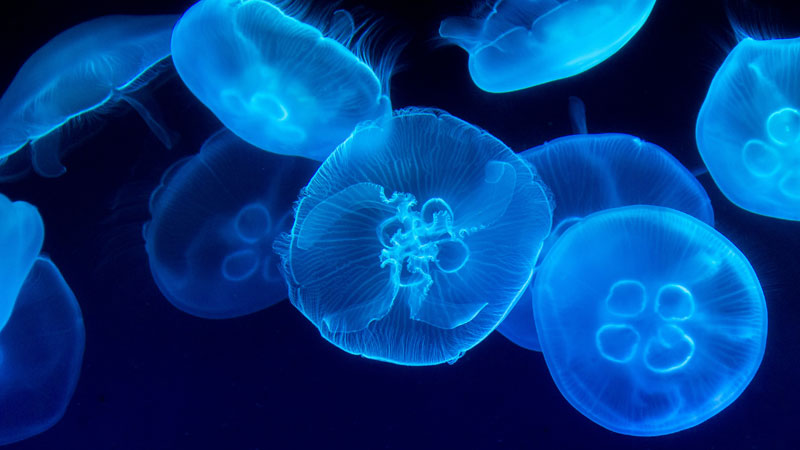Ultimate Guide to Jellyfish Outer Banks NC

Jellyfish are fascinating creatures found along the coast of the Outer Banks of North Carolina. These aquatic animals are known for their distinctive bell-shaped bodies and long, trailing tentacles, which they use to capture prey.
These aquatic animals are known for their unique, translucent bodies and long, flowing tentacles, which they use to capture their prey. Jellyfish are spotted in various colors, including shades of blue, purple, and even fluorescent pink.
Table of contents:
- Types of jellyfish found along the Outer Banks.
- What to do if you are stung.
- Are jellyfish dangerous?
- How to avoid getting stung.
- When is jellyfish season for the Outer Banks?

What types of jellyfish are found along the Outer Banks?
Moon Jellyfish
One of the most common jellyfish found along the coast of North Carolina is the moon jellyfish. These jellyfish are named for their distinctive white or translucent bell-shaped bodies, often marked with four purple rings.
Moon jellyfish are typically relatively small, with a bell that is only a few inches in diameter. However, their long tentacles can reach several feet, making them a sight when swimming through the water. Moon jellyfish are typically found in shallow waters, feeding small fish and plankton.
Sea Nettle Jellyfish
Another type of jellyfish that can be found along the coast of North Carolina is the sea nettle. These jellyfish are larger and more brightly colored than moon jellyfish, with long, stinging tentacles that can reach lengths of up to 10 feet.
Sea nettles are typically shades of pink or red, and their bell-shaped bodies can grow as large as a basketball. Despite their size and striking appearance, sea nettles are generally not aggressive and will only sting if provoked.
Lion's Mane Jellyfish
The lion's mane jellyfish is a truly fascinating creature. Its long, flowing tentacles and striking appearance are a sight to behold. However, despite its intimidating looks, the lion's mane jellyfish is quite gentle and poses little threat to humans.
One of the most exciting things about the lion's mane jellyfish is its size. It is the largest known species of jellyfish, with some individuals reaching over seven feet in diameter and tentacles that can extend over 120 feet in length. This makes it a truly massive creature, and it is a sight to behold when swimming through the water.
Another fascinating fact about this type of jellyfish is its lifespan. While most jellyfish only live for a few months, the lion's mane jellyfish can live for up to five years. This allows it to grow to its massive size and roam the oceans in search of food.
Despite its massive size and long lifespan, the lion's mane jellyfish is not a threat to humans. Its tentacles are covered in tiny stinging cells, but these are not strong enough to penetrate most people's skin. However, it is still best to avoid touching the tentacles, as they can still irritate.
What do you do if you are stung by a jellyfish?
If you are stung by a jellyfish, the most important thing to do is to stay calm. Jellyfish stings can be painful, but they are rarely life-threatening.
- The first thing you should do is remove any tentacles that are still attached to your skin. Then, you can use a stick or other object to gently scrape them off, being careful not to touch them with your bare hands. This is important because the tentacles can continue to release venom even after they are detached from the jellyfish.
- Next, rinse the affected area with seawater. Do not use fresh water, as this can cause the tentacles to release more venom.
- You can also use vinegar to help neutralize the venom, but avoid using alcohol or urine, as these can actually make the sting worse.
You can take over-the-counter pain medication such as ibuprofen or acetaminophen if the pain is severe. You can also apply a cold compress to the affected area to help reduce swelling and pain.
If you experience difficulty breathing or chest pain, or if the sting covers a large area of your body, seek medical attention immediately. These can be signs of a more serious reaction to the jellyfish sting.
It is also a good idea to avoid swimming in areas where jellyfish are known to be present. If you come into contact with a jellyfish, stay calm and follow the steps outlined above to help minimize the sting's effects.
Overall, jellyfish stings are not usually severe, but it is essential to take them seriously and seek medical attention if necessary. By following these steps, you can help ensure that you recover quickly and avoid any long-term effects from the sting.

Are jellyfish dangerous?
Jellyfish are fascinating to watch, but it is important to remember that they can be dangerous. Some species of jellyfish, such as the sea nettle and the box jellyfish, have venomous stings that can be painful and even deadly to humans. Therefore, if you come across a jellyfish swimming or boating along the coast of North Carolina, it is best to admire them from a safe distance and avoid touching them.
One of the most exciting things about jellyfish is their simple yet highly efficient anatomy. Unlike most other animals, jellyfish do not have a brain, heart, or bones. Instead, their bodies are made up of a loose network of nerves and muscles, which allows them to move gracefully through the water.
Despite their potential dangers, jellyfish are an important part of the marine ecosystem. They are a vital food source for many species of fish and other aquatic animals and help keep the ocean ecosystem balanced.
So next time you are at the beach in North Carolina, keep an eye out for these fascinating creatures and marvel at their beauty and grace as they glide through the water!
How do you avoid getting stung by a jellyfish?
Jellyfish stings can be painful and even dangerous, so it's important to take steps to avoid getting stung in the first place. Here are a few tips for avoiding jellyfish stings:
- Stay out of the water if you see jellyfish. If you see jellyfish in the water, it's best to avoid going in. Jellyfish are often found near the surface of the water, so if you see them floating on the surface, it's a good idea to stay on the beach.
- Wear protective clothing. If you decide to go in the water, consider wearing a wetsuit or other protective clothing covering your skin. This can help prevent jellyfish stings, as the jellyfish's tentacles will have a more challenging time reaching your skin.
- Use a protective barrier. If you're swimming in an area where jellyfish are known to be present, consider using a protective barrier like a jellyfish net. These nets can be placed around your body or your swim area to create a barrier between you and the jellyfish.
- Avoid swimming at night. Jellyfish are often more active at night, so avoiding swimming is best. If you do decide to go in the water at night, use a flashlight to help you spot any jellyfish that may be nearby.
Remember, the best way to avoid getting stung by a jellyfish is to stay out of the water if you see them. But if you do get stung, using vinegar and seeking medical attention if necessary can help alleviate the pain and prevent any further complications.
Stay safe, and enjoy your time in the water!
When is jellyfish season for the Outer Banks?
Jellyfish season on the Outer Banks is also the same time of year that many beachgoers look forward to. The warm summer waters are teeming with various jellyfish species, making for a truly unique and fascinating experience.
One of the most common jellyfish found on the Outer Banks during summer is the moon jellyfish. These jellyfish are typically transparent or white and have a distinctive circular shape with long, flowing tentacles. Moon jellyfish are not known to be particularly dangerous, but their stings can still be painful and cause irritation.
Another type of jellyfish that can be found on the Outer Banks during the summer is the Portuguese man-of-war. These jellyfish are much more venomous than moon jellyfish, and their stings can be excruciating. Portuguese man-of-war jellyfish are easily recognizable by their distinctive blue or purple color and long, trailing tentacles.
Despite the potential for jellyfish stings, many beachgoers still enjoy swimming in the waters of the Outer Banks during jellyfish season. Some people find that the jellyfish add to the overall beauty and intrigue of the ocean, and are willing to take the risk of a sting in order to experience them up close.
If you do decide to go swimming during jellyfish season on the Outer Banks, it's important to take some precautions to avoid getting stung. Wearing a full-body swimsuit or a protective jellyfish-proof suit can help to reduce the risk of a sting. It's also a good idea to avoid swimming near large groups of jellyfish and touching or swimming near any jellyfish that have washed up on the beach.
Jellyfish season on the Outer Banks is a unique and fascinating time of year. While some risks are involved, many people still enjoy the experience of swimming with these beautiful and mysterious creatures.
Conclusion
Despite their often-feared reputation, jellyfish are pretty mesmerizing to observe. They move gracefully through the water, pulsing their bell-shaped bodies to propel themselves forward. Some species are even bioluminescent, glowing brightly in the darkness of the deep sea.
Jellyfish are also essential members of the ocean ecosystem, serving as predators and prey. They feed on small fish and plankton and are eaten by larger predators like sea turtles and fish. Without jellyfish, the delicate balance of the ocean ecosystem would be disrupted.
Overall, jellyfish are fascinating creatures that are well worth learning more about. Whether you are an experienced scuba diver or just a casual beachgoer, the waters off the Outer Banks are a great place to see these beautiful and unique animals in their natural habitat.
If you're visiting the Outer Banks and enjoying one of the number one things to do, keep an eye out for jellyfish in the water. While it's best to admire them from a safe distance, seeing these fascinating creatures up close is a truly unforgettable experience!






I also would like to know what to do in the event of a sting.
What should I do if I step on a jellyfish, but do not get stung? Should I still stay out of the water?
Leave a comment